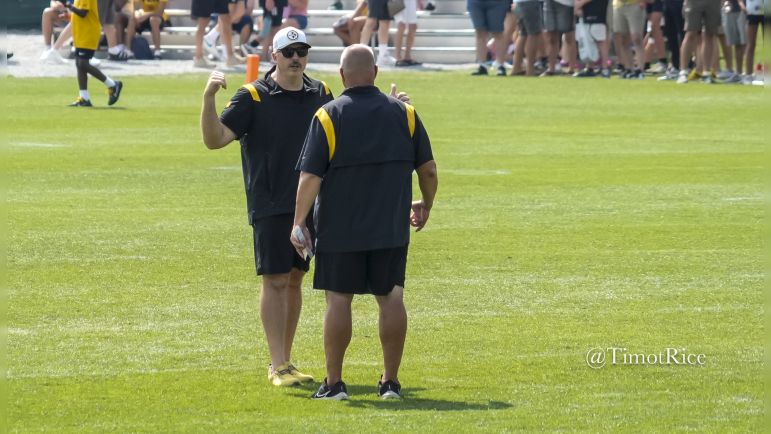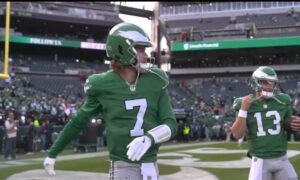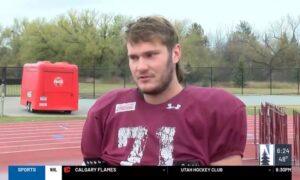With the Pittsburgh Steelers’ season over, it’s time to begin reviewing the last four months. Just as the team’s doing internally, we’ll look back at the roster and coaching staff to offer evaluations of how the units fared. Today, I’ll review the Steelers’ offensive coaching staff and share my thoughts on the coordinator and each main positional coach.
It’ll be as fair and nuanced of a take as possible on each coach, who are admittedly more difficult to evaluate than players and their actual game tape.
Offense
Offensive Coordinator Arthur Smith
It certainly was his offense. Top five in rushing attempts, bottom five in passing attempts, a high use of multi-tight end personnel groupings. In 2023, the Steelers ran 12 or 13 personnel 23.3 percent of the time. In 2024, that number spiked to 42.6 percent. Only one wide receiver outside of George Pickens got heavily involved and that was Van Jefferson, who ran nearly 400 routes but caught just 24 passes. In Smith’s world, that’s balance.
For part of the season, the offense appeared moving in the right direction. They were brought back to base and exceeded expectations and past results, at one point a top-10 scoring offense averaging roughly 24 points per game. With a top-five scoring defense, the Steelers had a recipe for success.
But the offense had fallen off a cliff by year’s end. Held at or under 17 points in five straight games for the first time since 1969, the running game tanked. Over the final four regular-season games, they lost their volume and often their efficiency. Pittsburgh was dreadful all season in short yardage and the league’s worst on first down, regressing even under the low bar Matt Canada set.
Smith avoided some of Canada’s pitfalls with play calling that felt less small menu and as predictable. There was a greater emphasis on layering plays and working off each other. But once the run game was sunk and the Steelers’ play-action became less effective, what the offense could do well shrunk to Russell Wilson chucking deep balls. And in three games without George Pickens, even that wasn’t viable.
Overall, the Steelers still made things too hard on themselves without enough easy wins on early downs to get the offense going and avoid third-and-long. They averaged 7.5-yards to go on third down, 25th in the league.
Their route concepts didn’t stress defenses enough, and the biggest long-standing criticism of Smith, not getting the ball to his top weapons, was on display. George Pickens went long stretches without seeing the ball and averaged just 1.6 targets in the first quarter, far less than other No. 1 wideouts in the league. Dallas Cowboys WR CeeDee Lamb averaged 3.1, the Cincinnati Bengals’ Ja’Marr Chase 2.5., the Atlanta Falcons’ Drake London 2.2.
Granted, Pickens played in a run-heavy offense and that number is a lot of broad that doesn’t consider other factors (number of players, how often a team received the ball first, giving them more possessions) but still Pickens wasn’t schemed up enough to shake the attention of defenses. This was a failure.
Smith did a nice job creating concepts to beat man coverage in wins over the New York Jets and Giants, but he and Wilson struggled to consistently beat zone. Defenses began shifting that way throughout the season and stunted the Steelers’ passing attack.
With the run game, Pittsburgh failed to find a true identity and scheme that consistently worked. The Steelers’ zone runs, Smith’s bread and butter, were an inconsistent and clunky mess while their “Crunch” scheme drawn up in a variety of ways couldn’t find traction. Hate for toss plays was overstated, which often were just variations of zone runs than true crack/tosses but they didn’t work either.
Smith was professional and despite how things ended, brought some level of respectability to the Steelers’ offense. Even with the sour finish, and no question it was miserable, Pittsburgh showed a baseline ability. But Smith really struggled when the road got tight. On a tough Thursday night on the road against Cleveland, his game plan was pathetic and reached Canada-levels of bad. Preparing on short weeks produced ugly results and he couldn’t find a way to climb out of the hole once the losing began.
Unless Smith becomes a head coach, and the Jets seem to be the best chance of that, he will return in 2025. With work to do.
RB Coach Eddie Faulkner
Positional coaches are especially tough to judge from the outside. Faulkner has been regarded as a quality one and someone the Steelers have made sure to hang onto with multiple contract extensions. Najee Harris flashed early in the season with more big runs than normal, but he regressed after the bye. In September and October, Harris had six runs of 20-plus yards. In November, December, and January, he had just three.
Still, Faulkner has done a nice job with the group, especially developing Jaylen Warren. Cordarrelle Patterson didn’t offer much but a veteran presence, Faulkner wasn’t going to have a major impact on his play one way or another. Overall, a solid coach who will likely be tasked with developing a rookie runner next season.
QB Coach Tom Arth
Pittsburgh’s quarterback coaching hire that flew under the radar, he was part of a brand-new group top to bottom. Arth had little NFL experience after spending most of his time a head coach in the college ranks.
Under him, Justin Fields’ mechanics were cleaned up and he became a steadier player. And Arth, like everyone else, had to adjust to starting Russell Wilson mid-stream as Mike Tomlin made the switch. A first-year positional coach is even more difficult to judge but I have little bad to say or infer even knowing that Pittsburgh couldn’t confidently find its quarterback of the future. More time here is needed.
WR Coach Zach Azzanni
Another new hire, we referred to Azzanni as the “butt-kicker” the Steelers needed. Tough love and no-nonsense, he wasn’t given a ton to work with, especially after rookie Roman Wilson suffered a lost season due to multiple injuries. Azzanni’s big mission was working with and hopefully stabilizing George Pickens. Did he? Ehhhhh.
Pickens continues to be difficult to control with maturity issues popping up nearly every week. Azzanni isn’t a babysitter and that can’t all be pinned on him, but it didn’t seem like he was able to settle Pickens to the degree he needs to after early camp friction.
Beyond him, Calvin Austin III had a nice breakout year following Azzanni talking him up throughout the spring and summer. Van Jefferson ran empty routes but it’s hard to put that on Azzanni. Similar to Arth, this evaluation feels a little incomplete, and how the group evolves will be important to watch under Azzanni. Especially under the assumption he’ll have new talent to work with next year.
TE Coach Alfredo Roberts
Roberts has developed practically the whole group of Steelers tight ends. He’s been the only coach Pat Freiermuth, Darnell Washington, and Connor Heyward have had throughout their NFL careers. Overall, the group has trended in a positive direction. Especially Washington, who took a noticeable jump as a sophomore. He greatly improved as a blocker and was more active and effective in pass protection. His snap timing really helped him fire off the ball and be more impactful, and he got more involved in the passing game even if he was hardly used down the stretch.
Freiermuth had a fine-not-great season, but I suppose was a better blocker than a year ago while Pittsburgh smartly detached him from the line more frequently. Heyward had an underwhelming year but doesn’t seem like a great system fit while MyCole Pruitt was inoffensive as an in-line blocker.
Overall, Roberts is a solid positional coach with tons of experience.
OL Coach Pat Meyer
We gotta talk about Pat Meyer. I can appreciate his calm demeanor that focuses on teaching than yelling and scolding. His first two years, the Steelers’ o-line improved once the players got comfortable using his techniques and the group seemed to be moving in the right direction even during a bumpy start to the year. Meyer helped juggle the team’s repeated injuries up front and the youth the team quickly counted on. Individually, there was growth from rookie center Zach Frazier and right guard Mason McCormick. Even veteran left Dan Moore Jr. was showing signs of growth and incremental progress.
But an o-line must be judged as a collective five. There, Pittsburgh failed. Despite good health post-bye, the group didn’t ascend. It plateaued and regressed. It is fair to believe the group was simply worn out and tired down the stretch, something we mentioned during the losing streak and Mike Tomlin denied before admitting it during his year-end press conference. Rookies like Frazier and McCormick were college veterans but guys who haven’t had much of a break since their senior seasons began. It was asking a lot.
Regardless, the line wasn’t cohesive. Zone runs became a mess with too many players off-track and not coordinating well on second-level blocks. It led to free-running linebackers and crushed the ground game. The young linemen struggled to identify and pick up stunts. Moore and LG Isaac Seumalo had fewer issues, but the youth of this unit was exploited by rushes. RT Broderick Jones did not have a good sophomore year and his future as a starting-caliber tackle is in question, though he’ll likely be given a starting role next season in the hopes of turning things around.
Overall, the line was a big reason for the offense’s problems at the end of the year. This unit was supposed to be a potential top-10 group by year’s end. Instead, it isn’t a much stronger unit than how it began the season. For all that’s been invested here, this group has to succeed. Pittsburgh can’t afford to be wrong. Which could mean a change in coach.
Though I believe Meyer is under contract through 2025, if there is a name to change, it’s his. Pittsburgh has missed on too many o-line coaches, and it’s quietly hurt this team. From Shaun Sarrett to Adrian Klemm to (interim) Chris Morgan to Meyer, the Steelers have bounced among coaches and been unable to properly develop the unit.
There has to be an urgency here to make the o-line the strength of the offense. It’s how Pittsburgh was supposed to build its entire unit as a bully, beat-you-up outfit. That means making a tough decision, firing Meyer, and bringing someone else in. Someone who I suspect would have a stronger NFL playing resume similar to Munchak, which isn’t the end-all but increases credibility.








